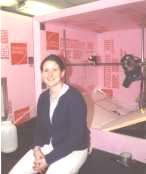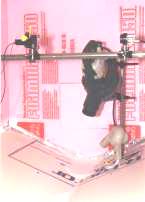 |
 Experiment schematic |
 What's in the box? |
Light Transmission and Spatial Distribution of Pellets
in Fully Developed Air Turbulence
Cortney Terrillion ‘99
Abstract:
Accurate climate modeling would require a good understanding of the role of clouds in how much light is transmitted to the Earth’s surface. Studying an actual cloud has a lot of uncontrollable parameters, so a simpler model of a cloud will be used in an attempt to understand the spatial distribution of water droplets within the cloud. Are they independently distributed or are they clumping? A cloud was simulated using polystyrene pellets, representing water droplets, perturbed in a box of dimensions 1.11m x 1.11m x 1.11m by a leaf blower. The fraction of light transmitted versus distance was measured and was used to determine the extinction coefficient. If the pellets are independently distributed randomly in the box, then we would expect a graph of standard deviation of the extinction coefficient versus distance to be ![]() where a is a constant and x is distance. However, from our data, we determined this dependence to be
where a is a constant and x is distance. However, from our data, we determined this dependence to be ![]() . This is sufficient to conclude that pellets are not independently distributed. However, there is not enough evidence to conclude that the pellets are clumping.
. This is sufficient to conclude that pellets are not independently distributed. However, there is not enough evidence to conclude that the pellets are clumping.
For more information, contact Dr. Brian Watson:
|
|
||
| © | St. Lawrence University | Department of Physics |
| Revised: 25 Jan 06 | Canton, NY 13617 |